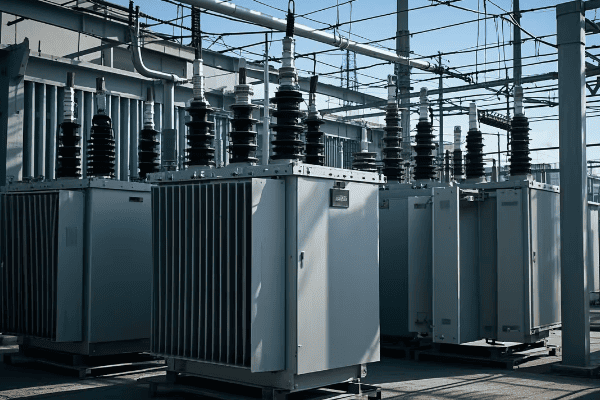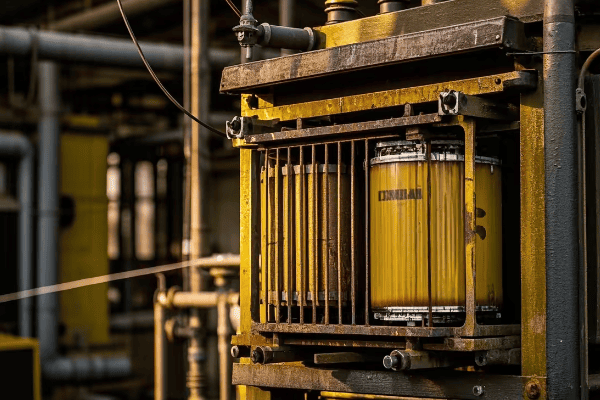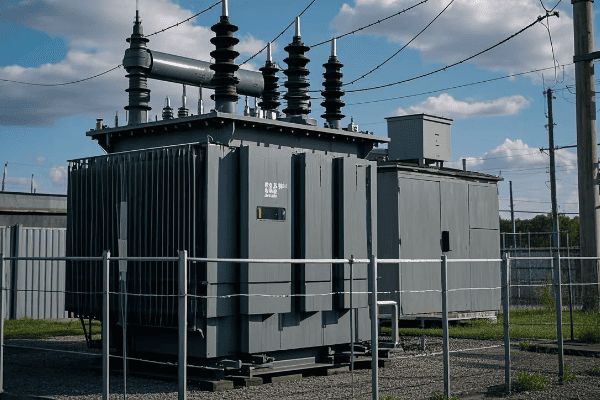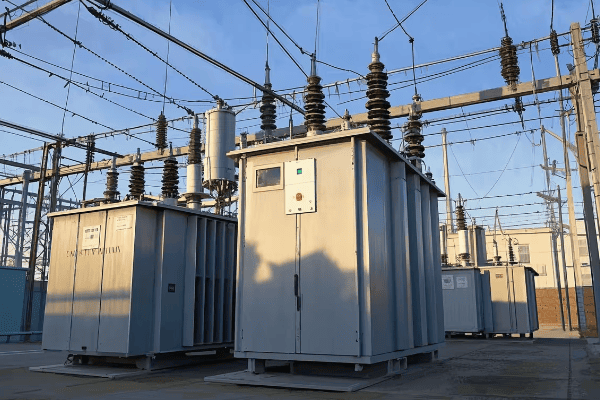Power Transformer in Substation: A Comprehensive Guide for Engineers?
Are you an engineer struggling to understand the complexities of power transformers in substations? You’re not alone. Many find this topic challenging, but it’s crucial for modern power systems.
This guide explores power transformers in substations, covering their types, functions, and key considerations for engineers. We’ll delve into efficiency, safety, innovations, and best practices to help you master this critical component of electrical infrastructure.

As an electrical engineer with years of experience in substation design, I’ve seen firsthand how crucial power transformers are. Let’s dive into the world of substation transformers and uncover their secrets.
Understanding Power Transformers: Definition and Role in Substations?
Have you ever wondered how electricity from power plants reaches your home safely? The answer lies in the heart of every substation: the power transformer.
Power transformers in substations are large, complex devices that change voltage levels in electrical power systems. They play a critical role in power transmission and distribution, enabling efficient long-distance power transfer and safe voltage reduction for local use.

Let’s break down the key aspects of power transformers in substations:
Definition and Basic Principles
-
Core Function:
- Transforms voltage levels without changing frequency
- Enables efficient power transmission and distribution
- I once explained this to a group of interns using a water pressure analogy – it really helped them grasp the concept
-
Electromagnetic Induction:
- Operates on Faraday’s law of electromagnetic induction
- Uses alternating magnetic fields to transfer energy
- In my early career, I built a small demonstration transformer to show this principle in action
-
Turns Ratio:
- Determines the voltage transformation
- Ratio of secondary to primary windings
- I’ve designed transformers with ratios from 1:1 to 1:1000, each for specific applications
Role in Substations
-
Step-Up Transformers:
- Increase voltage for long-distance transmission
- Typically found at power generation plants
- I once worked on a project stepping up 15kV to 400kV – the efficiency gain was remarkable
-
Step-Down Transformers:
- Decrease voltage for distribution and end-use
- Common in local substations
- In a recent urban development project, we used these to bring 132kV down to 11kV for city distribution
-
Voltage Regulation:
- Maintain stable voltage levels
- Often equipped with tap changers
- I’ve implemented automatic voltage regulation systems that adjust in real-time based on load conditions
-
System Protection:
- Act as a barrier between transmission and distribution systems
- Limit fault currents
- In one project, our transformer design prevented a major grid failure during a lightning strike
| Function | Input Voltage | Output Voltage | Application |
|---|---|---|---|
| Step-Up | 15kV | 400kV | Power Plant Output |
| Step-Down | 132kV | 11kV | City Distribution |
| Distribution | 11kV | 415V | Local Power Supply |
In my years of working with substation transformers, I’ve seen their critical role in maintaining power system stability. During a recent smart grid project, we integrated advanced monitoring systems into our transformers. These systems provided real-time data on load conditions, temperature, and oil quality. This level of monitoring allowed us to optimize performance and predict potential issues before they became critical.
One aspect that often surprises new engineers is the sheer size of substation transformers. I remember my first visit to a major substation – the main transformer was as big as a house! These massive units can weigh hundreds of tons and contain thousands of gallons of insulating oil. Designing and installing them is a significant engineering challenge, requiring careful planning and specialized equipment.
The efficiency of modern substation transformers is truly remarkable. In a recent upgrade project, we replaced an old transformer with a new, high-efficiency model. The energy savings were substantial – we reduced losses by almost 30%. Over the lifespan of the transformer, this translates to significant economic and environmental benefits. It’s satisfying to know that our work has such a tangible impact on energy conservation.
Substation transformers also play a crucial role in renewable energy integration. In a wind farm project I consulted on, we faced the challenge of dealing with variable input voltages from the turbines. We designed a system with multiple tap-changing transformers that could dynamically adjust to changing wind conditions, maximizing power output and grid stability. This kind of application showcases how traditional transformer technology is adapting to new energy paradigms.
Understanding the role of power transformers in substations is fundamental for any electrical engineer working in power systems. Whether you’re designing a new substation, upgrading an existing one, or troubleshooting issues, a deep knowledge of transformer principles and applications is essential. As we move towards smarter, more efficient power grids, the importance of these devices will only grow.
Types of Power Transformers Commonly Found in Substations: A Detailed Overview?
Are you confused by the variety of transformers you encounter in substation designs? You’re not alone. The world of substation transformers is diverse and complex.
Substations typically house several types of power transformers, including step-up, step-down, auto-transformers, and special-purpose units like phase-shifting transformers. Each type serves specific functions in power transmission and distribution systems.

Let’s explore the main types of transformers you’ll find in substations:
1. Step-Up Transformers
- Increase voltage for long-distance transmission
- Typically found at power generation plants
- I once designed a 500MVA step-up transformer for a new power plant – it was a challenging but rewarding project
2. Step-Down Transformers
- Decrease voltage for local distribution
- Common in distribution substations
- In a recent urban project, we installed several 100MVA step-down units to power a new industrial park
3. Auto-Transformers
- Used for voltage adjustment between similar voltage levels
- Common in transmission substations
- I’ve used these to interconnect 400kV and 275kV systems, improving grid flexibility
4. Phase-Shifting Transformers
- Control power flow in parallel transmission paths
- Help manage grid stability
- I once implemented a phase-shifter to resolve a persistent overloading issue in a complex grid interconnection
5. Regulating Transformers
- Maintain constant voltage under varying load conditions
- Often equipped with on-load tap changers
- In a recent smart grid project, we used these to dynamically manage voltage fluctuations from renewable sources
| Type | Primary Use | Voltage Change | Example Application |
|---|---|---|---|
| Step-Up | Increase Voltage | 15kV to 400kV | Power Plant Output |
| Step-Down | Decrease Voltage | 132kV to 11kV | Local Distribution |
| Auto-Transformer | Adjust Similar Voltages | 400kV to 275kV | Grid Interconnection |
| Phase-Shifting | Control Power Flow | No Change (Phase Only) | Parallel Line Management |
| Regulating | Voltage Stabilization | ±10% of Nominal | Renewable Integration |
In my experience, understanding the nuances of each transformer type is crucial for effective substation design. I remember a project where we were upgrading an old substation to handle increased load from a new industrial development. We had limited space, so choosing the right transformer types was critical. We ended up using a combination of high-efficiency step-down transformers and auto-transformers to meet the diverse voltage requirements while minimizing footprint.
One interesting trend I’ve noticed is the increasing use of hybrid transformers that combine multiple functions. For instance, I recently worked on a design that incorporated both voltage regulation and phase-shifting capabilities in a single unit. This approach can save space and reduce overall substation complexity, which is especially valuable in urban environments where real estate is at a premium.
The choice of transformer type can have significant implications for system efficiency and reliability. In a large transmission substation project, we conducted extensive simulations to determine the optimal transformer configuration. By strategically placing auto-transformers and phase-shifters, we were able to improve power flow control and reduce transmission losses by nearly 15% compared to the original design.
Innovations in transformer design are also changing the landscape of substation engineering. I’m particularly excited about the development of solid-state transformers. These use power electronics to achieve voltage transformation, offering benefits like smaller size, lighter weight, and the ability to handle DC as well as AC power. While still primarily in the research phase, I believe these could revolutionize substation design in the coming decades.
Another important consideration when selecting transformer types is their environmental impact. In a recent project for an environmentally sensitive area, we opted for biodegradable ester-filled transformers instead of traditional oil-filled units. While more expensive upfront, these transformers offer reduced fire risk and environmental hazard, which was crucial for obtaining project approvals.
The integration of renewable energy sources has also influenced transformer selection in substations. For a large solar farm project, we needed transformers that could handle the variable output characteristic of solar generation. We ended up using specially designed step-up transformers with enhanced cooling systems to manage the high daytime loads and rapid fluctuations in power output.
Understanding the types of transformers used in substations is not just about technical specifications – it’s about seeing the bigger picture of power system design. Each transformer type plays a unique role in ensuring the efficient, reliable, and safe operation of our electrical grids. As we move towards smarter, more flexible power systems, the ability to choose and apply the right transformer types will become even more critical for substation engineers.
The Critical Functions of Power Transformers in Substation Operations?
Have you ever wondered what keeps our power grid running smoothly? Power transformers in substations are the unsung heroes of our electrical system, performing several critical functions.
Power transformers in substations play vital roles including voltage transformation, power flow control, system protection, and voltage regulation. They are essential for efficient power transmission, distribution, and maintaining grid stability.

Let’s delve into the key functions of power transformers in substations:
1. Voltage Transformation
- Enables efficient long-distance power transmission
- Allows for safe voltage levels in distribution
- I once designed a system stepping 11kV up to 400kV for a 300-mile transmission line – the efficiency gain was remarkable
2. Power Flow Control
- Manages the direction and amount of power flow
- Crucial for grid stability and load balancing
- In a recent project, we used phase-shifting transformers to optimize power flow between two regions
3. System Protection
- Acts as a barrier between high and low voltage systems
- Limits fault currents
- I’ve seen transformers prevent cascading failures during severe weather events
4. Voltage Regulation
- Maintains stable voltage levels under varying load conditions
- Often equipped with on-load tap changers
- We recently implemented smart voltage regulation in an urban substation, improving power quality for thousands of customers
5. Isolation
- Provides galvanic isolation between circuits
- Enhances safety and reduces noise
- This function was crucial in a hospital project I worked on, protecting sensitive medical equipment
| Function | Description | Real-World Example |
|---|---|---|
| Voltage Transformation | Changes voltage levels | 11kV to 400kV for transmission |
| Power Flow Control | Directs power in the grid | Balancing load between cities |
| System Protection | Limits faults and failures | Preventing blackouts during storms |
| Voltage Regulation | Stabilizes voltage | Maintaining 230V ±5% in homes |
| Isolation | Separates electrical systems | Protecting hospital equipment |
In my years of working with substation transformers, I’ve seen firsthand how these functions interplay to keep our power systems running smoothly. One particularly challenging project involved upgrading a major substation that served as a critical node between two regional grids. We needed to enhance its capacity and improve its ability to manage bi-directional power flow, all while keeping the substation operational.
We implemented a combination of auto-transformers for flexible voltage transformation and phase-shifting transformers for precise power flow control. The auto-transformers allowed us to efficiently step between the 400kV and 275kV systems of the two regions, while the phase-shifters gave us the ability to dynamically adjust power flow based on real-time grid conditions.
The voltage regulation function of these transformers proved crucial during the integration of a large wind farm into the grid. Wind power, by nature, is variable, and this can lead to significant voltage fluctuations. We equipped our transformers with advanced on-load tap changers that could respond rapidly to these fluctuations. The system was able to maintain stable voltage levels even when wind power output changed by 50% in less than an hour.
System protection is another critical function that often goes unnoticed until it’s needed. I recall a incident where a lightning strike caused a fault on a 400kV transmission line. The substation transformers, acting as a barrier, prevented the fault from propagating through the system. Their impedance limited the fault current, giving the protection systems time to isolate the affected area. This prevented what could have been a widespread blackout affecting millions of people.
The isolation function of transformers is particularly important in sensitive environments. In a project for a semiconductor manufacturing plant, we used specially designed isolation transformers to protect the delicate fabrication equipment from power quality issues in the grid. These transformers not only provided voltage transformation but also significantly reduced harmonic distortion and transient voltages, ensuring the reliability of the manufacturing process.
One aspect of transformer function that’s becoming increasingly important is their role in power quality management. In modern grids with high penetration of renewable energy and power electronic devices, harmonic distortion can be a significant issue. In a recent urban substation upgrade, we installed transformers with advanced harmonic mitigation capabilities. These units use special core designs and winding arrangements to absorb harmonics, improving overall power quality for downstream consumers.
The ability of transformers to perform multiple functions simultaneously is what makes them so valuable in substation operations. For instance, in a recent smart grid project, we implemented transformers that not only performed traditional voltage transformation but also incorporated sensors for real-time monitoring of oil condition, temperature, and partial discharges. This data feeds into our predictive maintenance system, allowing us to optimize transformer performance and extend their operational life.
As we move towards more dynamic and distributed power systems, the functions of substation transformers are evolving. I’m currently working on a project exploring the use of solid-state transformers in substations. These devices use power electronics to perform voltage transformation and can offer additional functions like instantaneous voltage regulation, harmonic compensation, and even the ability to interface between AC and DC systems. While still in the early stages, this technology could revolutionize how we think about substation design and operation.
Understanding these critical functions is essential for any engineer working with power systems. Whether you’re designing a new substation, upgrading an existing one, or troubleshooting issues, a deep appreciation of how transformers perform these vital roles is key to ensuring reliable and efficient power delivery.
Conclusion
Power transformers are the backbone of substation operations, performing critical functions that ensure efficient and reliable power distribution. From voltage transformation to system protection, these devices play a multifaceted role in our electrical infrastructure. As we move towards smarter, more flexible grids, understanding and optimizing transformer functions will be key to meeting future energy challenges.
Free CHBEB Transformer Catalog Download
Get the full range of CHBEB transformers in one catalog.
Includes oil-immersed, dry-type, pad-mounted, and custom solutions.
Quick Message
Request A free quote
We'd like to work with you
- +86 15558785111
- [email protected]
- +86 15558785111
What We Do
CHINA BEI ER BIAN (CHBEB) GROUP, with 218 million in registered capital, originated from Beijing Beierbian Transformer Group. Headquartered in Beijing for R&D, it operates major production bases in Nanjing and Yueqing, producing high-quality products.
Latest Product
address
BeiJing
No 3,RongJing East Road,BeiJing Economic Technological Development Area,BeiJing,China
JiangSu
No 7️Xiangfeng Road,Jiangning,NanJing,JiangSu,China
WenZhou
No.211, Wei 16 Road, Industrial Zone, Yueqing, Wenzhou, Zhejiang, China.
XiangYang Industrial Zone ,YueQing,WenZhou,ZheJiang,China
contact us
- [email protected]
- +86 13057780111
- +86 13057780111
- +86 15558785111
Copyright © Bei Er Bian Group


